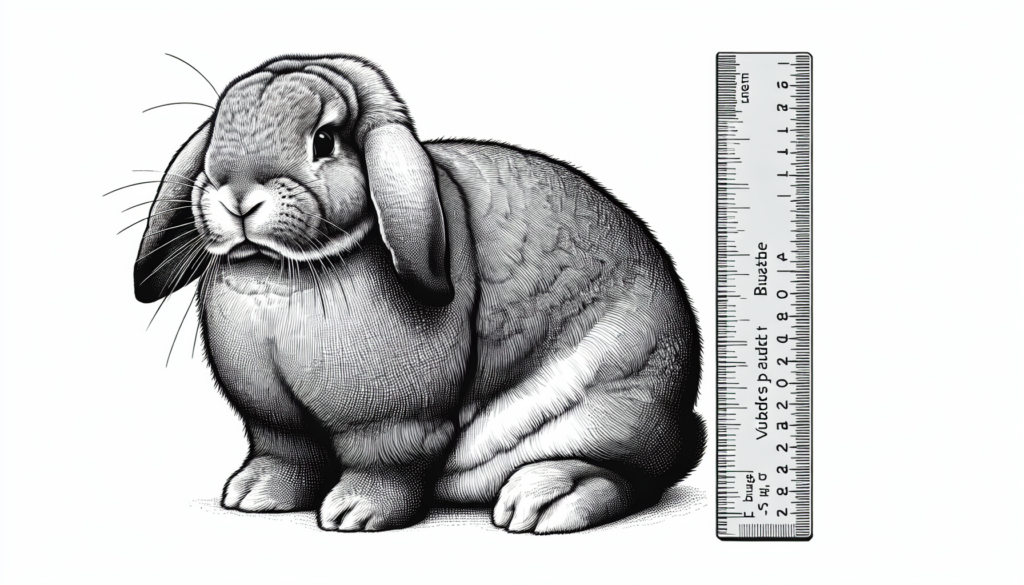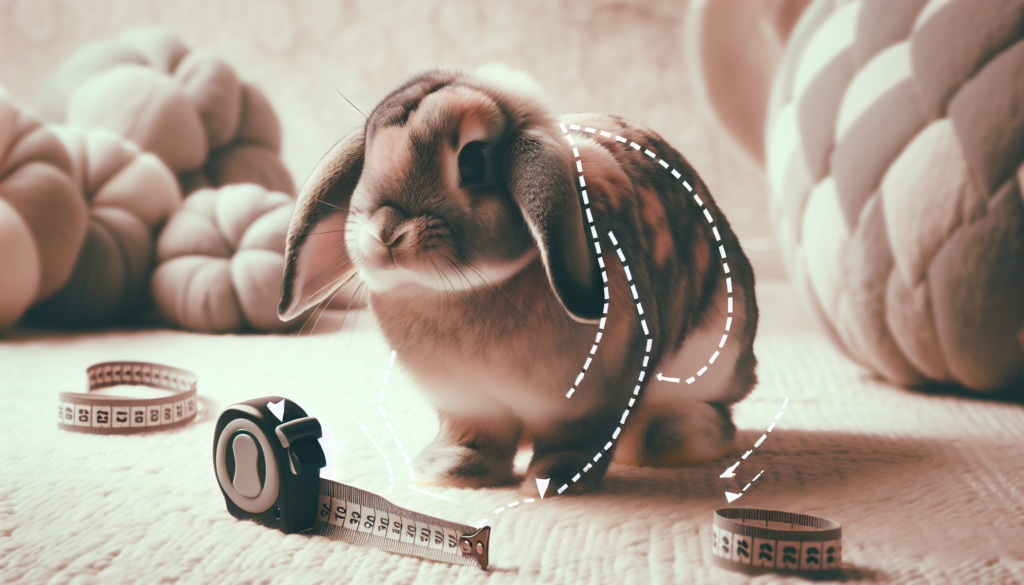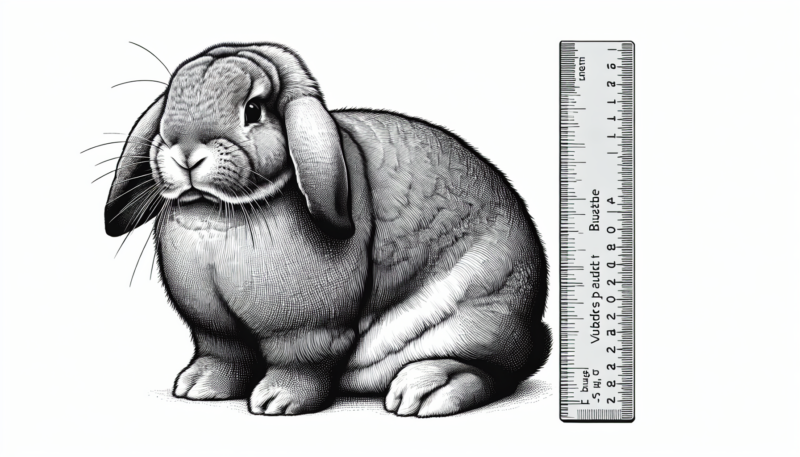Do you find yourself wondering how big a Holland Lop Rabbit can actually get? Well, look no further! In this article, we will explore the key factors that determine the size of a Holland Lop Rabbit, helping you gain a better understanding of their growth potential. From genetics to diet, we’ve got you covered. So, let’s hop right in and discover the fascinating world of Holland Lop Rabbits!
Overview of Holland Lop Rabbits
Brief introduction to Holland Lop rabbits
Holland Lop rabbits are a popular breed known for their adorable and distinctive appearance. They are characterized by their small size, compact body, and floppy ears, which give them a charming and cuddly appearance. These rabbits are well-loved as pets due to their friendly and gentle nature, making them suitable companions for both children and adults.
Physical characteristics of Holland Lop rabbits
Holland Lop rabbits are known for their compact and rounded bodies. They have short legs, a broad head, and a well-muscled frame. The most prominent feature of the breed is their lopped ears that hang down alongside their face. The average weight of adult Holland Lop rabbits varies, ranging between 2 to 4 pounds, depending on their genetics, nutrition, and overall health.
Factors Affecting the Size of Holland Lop Rabbits
Genetics and breed standards
The size of a Holland Lop rabbit is primarily determined by its genetics. Breeders work diligently to adhere to breed standards, which specify the desired size and body proportions for the Holland Lop breed. By selectively breeding rabbits that meet these standards, breeders can influence the size of future generations.
Nutrition and diet
Proper nutrition plays a vital role in the size and growth of Holland Lop rabbits. A well-balanced diet that includes fresh hay, high-quality pellets, and a variety of fresh vegetables is crucial for their overall health and size development. Providing the right nutrients in appropriate quantities ensures proper growth and prevents both underweight and overweight conditions.
Health and care
A rabbit’s overall health and care can impact its size. Regular check-ups with a veterinarian and prompt treatment of any health issues are essential for maintaining optimal growth. Ensuring a clean and stimulating environment, regular exercise, and proper grooming also contribute to a rabbit’s overall well-being and size development.
Exercise and activity level
Regular exercise and physical activity are important for maintaining a healthy size in Holland Lop rabbits. Adequate space to explore, hop, and play is necessary for their physical and mental well-being. Engaging in daily exercise not only helps in maintaining a proper body weight but also promotes good muscle development and overall vitality.

Determining Adult Size of Holland Lop Rabbits
Observing the parents and lineage
One way to estimate the adult size of a Holland Lop rabbit is by observing its parents and lineage. Genetics heavily influence the size of rabbits, so looking at the size of the parents can provide a good indication of what to expect in their offspring. If the parents are smaller in size, it is more likely that the rabbit will also be smaller when fully grown.
Consulting breed standards
Referring to breed standards can give valuable insights into the expected size of a Holland Lop rabbit. These standards outline the ideal characteristics, including size, that a rabbit of this breed should possess. Breeders and experienced Holland Lop rabbit enthusiasts can provide guidance on how to interpret and apply these standards when determining the size of a rabbit.
Analyzing growth patterns
Tracking the growth patterns of a Holland Lop rabbit can be helpful in estimating its adult size. By monitoring their weight and measuring their body length and height at regular intervals, you can observe how they are progressing in comparison to average growth patterns for the breed. This information can provide a rough estimate of their final size.
Monitoring weight and body condition
Regularly weighing a Holland Lop rabbit and assessing its body condition can aid in determining its size. A healthy rabbit should have a well-proportioned body with a visible waistline and a firm, but not overly bony, feel when gently touched. By observing their weight gain over time and comparing it to weight ranges for the breed, you can gauge their size development.
Average Size Range of Holland Lop Rabbits
Typical weight range for adult Holland Lop rabbits
The average weight range for adult Holland Lop rabbits is typically between 2 to 4 pounds. However, it’s important to note that individual rabbits may fall outside this range due to genetic factors and other influences. Some may be slightly smaller, while others may be slightly larger, but staying within this weight range is generally considered healthy for the breed.
Average body length and height
Holland Lop rabbits have an average body length of around 10 to 12 inches and stand at a height of approximately 8 to 12 inches. These measurements may vary slightly from rabbit to rabbit, but it provides a general idea of their size. Due to their compact and sturdy build, Holland Lop rabbits exhibit a charming and adorable appearance, regardless of their specific measurements.
Comparison with other rabbit breeds
When comparing the size of Holland Lop rabbits to other rabbit breeds, they are considered to be small to medium-sized rabbits. Their compact build and short legs contribute to their petite appearance. In contrast, larger rabbit breeds, such as the Flemish Giant, can reach weights of 14 pounds or more. It’s important to consider the projected size of the breed when determining if a Holland Lop rabbit is the right fit for your lifestyle.

Recognizing Dwarf and Micro Holland Lop Rabbits
Distinguishing Dwarfs from standard Holland Lops
Dwarf Holland Lop rabbits are a smaller variant of the standard Holland Lop breed. They typically range in weight from 1.5 to 2.5 pounds, making them even tinier than their standard counterparts. Dwarfs have the same physical characteristics as regular Holland Lop rabbits, but they are bred specifically for their reduced size.
Understanding characteristics of Micro Holland Lops
Micro Holland Lop rabbits are the smallest of the Holland Lop breed and often weigh less than 1.5 pounds. They retain the same charming appearance as regular Holland Lops but are bred to achieve an even tinier size. Due to their small stature, Micro Holland Lops require special care and attention to ensure their health and well-being.
Special considerations for Dwarf and Micro breeds
If you are considering a Dwarf or Micro Holland Lop rabbit, it’s important to be aware of their specialized needs. These smaller rabbits may require additional monitoring of their health, as they can be more susceptible to certain health issues. Providing a safe and secure environment that allows for proper exercise and minimizing any potential hazards is crucial for their well-being.
Importance of Size in Holland Lop Rabbit Selection
Determining suitability for different living conditions
The size of a Holland Lop rabbit is an important factor to consider when selecting a pet for your living conditions. Their small to medium size makes them well-suited for both apartments and houses with limited space. If you have limited indoor or outdoor space, a Holland Lop rabbit can comfortably thrive without feeling cramped or confined.
Compatibility with children and other pets
Holland Lop rabbits’ size also makes them an excellent choice for families with children and other pets. Their gentle and friendly nature, coupled with their small stature, makes them less intimidating for young children. However, it is crucial to supervise interactions between rabbits and younger children to ensure the safety and well-being of both parties.
Space requirements and housing considerations
The size of a Holland Lop rabbit will determine the space requirements and housing considerations needed. They need enough space to move around comfortably and stretch their legs. Providing them with appropriate housing options, including a spacious and well-ventilated hutch or cage, ensures that they have a safe and comfortable living environment.
Health Issues Associated with Holland Lop Rabbit Size
Potential problems related to large size
While Holland Lop rabbits are generally a healthy breed, large-sized individuals may be prone to certain health issues. These can include musculoskeletal problems, such as arthritis or joint pain, due to the added stress on their bones and joints. Additionally, obesity can be more prevalent in larger rabbits, putting them at risk for other weight-related conditions.
Common health issues in smaller Holland Lops
In smaller Holland Lop rabbits, some common health issues may arise due to their compact size. Dental problems, such as malocclusion, can be more frequent in rabbits with smaller mouths. Careful monitoring of their teeth and providing a proper diet rich in hay and fibrous vegetables can help prevent dental issues in these smaller breeds.
Weight-related concerns and prevention
Maintaining a healthy weight is crucial for the overall well-being of Holland Lop rabbits. Obesity can lead to a range of health problems, including heart disease, joint issues, and a decreased lifespan. Regular exercise, a balanced diet, and monitoring their weight can help prevent weight-related concerns and ensure they stay at a healthy size throughout their lives.
Feeding and Nutrition for Appropriate Growth
Feeding guidelines for Holland Lop rabbits
Providing a well-balanced diet is essential for the proper growth and development of Holland Lop rabbits. Their diet should consist primarily of fresh hay, such as Timothy or orchard grass, which is essential for their digestive health. Additionally, high-quality pellets formulated specifically for rabbits should be offered in moderate quantities. Fresh vegetables, such as leafy greens and a variety of herbs, can be provided as treats and to encourage foraging behavior.
Balancing essential nutrients for proper development
To ensure proper growth, Holland Lop rabbits require a balanced intake of essential nutrients. This includes a mix of protein, fiber, vitamins, and minerals. High fiber content from hay and pellets helps maintain healthy digestion, while moderate protein levels support muscle development. Offering a variety of vegetables contributes to a well-rounded and nutritionally balanced diet.
Avoiding overfeeding and obesity
Overfeeding can lead to obesity in Holland Lop rabbits and is a significant concern for their health. It’s important to follow appropriate feeding guidelines and portion control to prevent excessive weight gain. Providing measured amounts of pellets, monitoring treat intake, and allowing plenty of exercise will help prevent overfeeding and maintain a healthy weight.
Exercise and Enrichment for Optimal Size
Importance of exercise for maintaining healthy size
Regular exercise is crucial for maintaining a healthy size in Holland Lop rabbits. Exercise helps stimulate their metabolism, supports muscle development, and prevents obesity. Providing them with ample opportunity to hop, explore, and play in a safe and supervised environment ensures they get the exercise they need to stay fit and healthy.
Providing appropriate toys and activities
Enriching a Holland Lop rabbit’s environment with appropriate toys and activities is essential for their mental and physical stimulation. Providing tunnels, chew toys, puzzle feeders, and interactive playthings can keep them engaged and prevent boredom. This promotes natural behaviors and encourages exercise throughout the day.
Creating a stimulating environment for growth
Creating a stimulating environment is important for optimal size and overall well-being in Holland Lop rabbits. Encouraging them to explore different areas of their living space, providing safe hiding places, and offering a variety of textures and surfaces to play on can keep them mentally engaged and encourage movement and exercise, promoting healthy growth and development.
Care Tips for Holland Lop Rabbits of Different Sizes
Grooming requirements
Regardless of size, all Holland Lop rabbits require regular grooming to maintain a healthy coat and overall cleanliness. This includes gentle brushing to remove loose fur and prevent matting, as well as regular nail trims. Smaller rabbits may require extra attention when grooming their lopped ears to ensure they are free from any debris or infections.
Litter training techniques
Litter training is an essential aspect of caring for Holland Lop rabbits of all sizes. Providing a suitable litter box filled with rabbit-safe litter and placing it in a quiet and easily accessible area encourages them to use it consistently. Positive reinforcement and patience are key when teaching a rabbit to use a litter box, regardless of its size.
Veterinary care and check-ups
Regular veterinary care and check-ups are vital for the health and well-being of Holland Lop rabbits. This includes vaccinations, annual wellness exams, and prompt treatment of any health issues. Regular dental check-ups are particularly important for smaller rabbits to ensure their teeth are properly aligned and prevent potential dental problems.
In conclusion, Holland Lop rabbits come in various sizes, with the average adult weight ranging from 2 to 4 pounds. Factors such as genetics, nutrition, health, and exercise contribute to the size development of these rabbits. Recognizing the difference between standard, dwarf, and micro breeds is important when considering their size requirements and care. Proper feeding, exercise, and grooming, along with regular veterinary care, are crucial for maintaining optimal size and health in these adorable and friendly rabbits.
